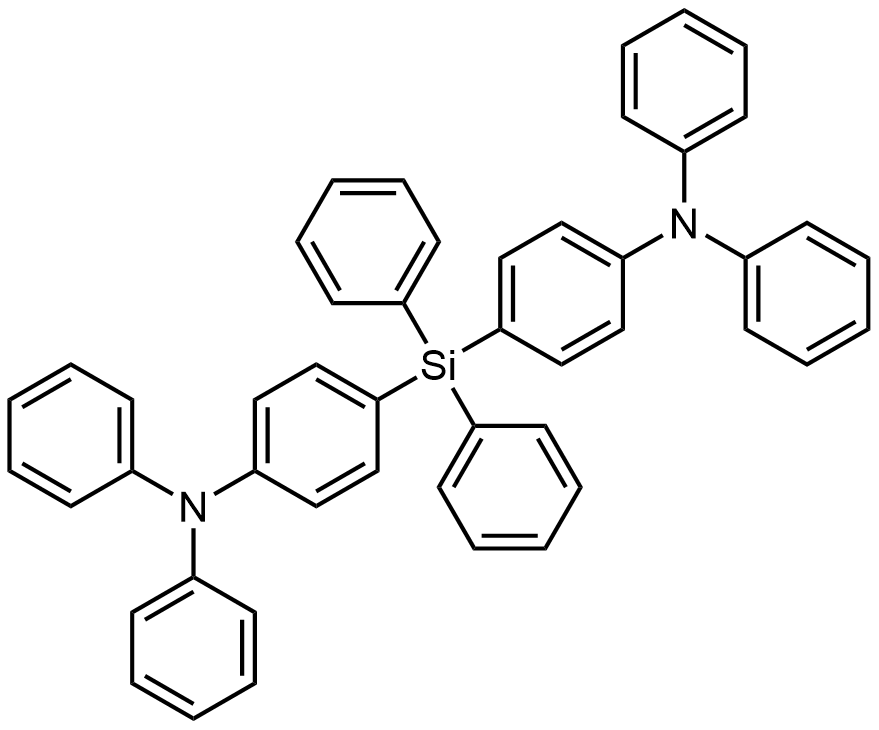The content on our website is provided solely for general informational purposes. It should not be considered, nor is it intended to provide advice or recommendations for the purchase, sale, or trade of any products or services. Importantly, the information presented does not constitute an offer to sell or a solicitation of an offer to buy any product.
Please be aware that the availability of our products may vary across different markets due to regulatory restrictions or other considerations. Consequently, not all products or services may be available in your region or country. For specific inquiries regarding the availability and pricing of any product, please contact us at sales@noctiluca.eu.
General information
-
Name:
TSBPA
-
Full name:
4,4'-(Diphenylsilanediyl)bis(N,N-diphenylaniline)
-
CAS number:
205327-13-5
-
Chemical formula:
C48H38N2Si
-
Molecular weight:
670.91 g/mol
-
Absorption:
λmax = 309 nm in DCM
-
Photoluminescence:
λmax = 376 nm in DCM
-
HOMO/LUMO:
HOMO = 5.5 eV, LUMO = 2.3 eV
-
Synonyms:
-
-
Classification:
Organic light-emitting diodes, Hole transport layer materials (HTL), Electron blocking layer materials (EBL), TADF materials, Exciplex materials, PHOLED materials, Host materials
-
Purity:
Sublimed: >99.0% (HPLC)
-
Melting point:
213 °C, Tg = 84 °C
-
Appearance:
White powder/crystals
TSBPA: Revolutionizing OLED Material Technology
TSBPA, or 4,4′-(Diphenylsilanediyl)bis(N,N-diphenylaniline) with the CAS number 205327-13-5 and chemical formula C48H38N2Si, is a state-of-the-art compound playing a pivotal role in the OLED industry. TSBPA is a prime choice for various roles in OLED fabrication, including hole transport layers (HTL) and electron blocking layers (EBL).
The Molecular Structure and Properties of TSBPA
Understanding TSBPA’s molecular structure is key to appreciating its functionality in OLED applications. Its structure is based on two triphenylamine groups connected to diphenylsilyl. The compound’s distinct HOMO level of 5.5 eV and LUMO level of 2.3 eV make it highly suitable for efficient charge transport and blocking within OLED devices.
We provide TSBPA with a purity exceeding 99.0%, as verified by HPLC analysis. This high purity level is crucial for the consistent performance of OLEDs, ensuring reliability and efficiency.
Key Features of TSBPA
- Advanced Electronic Stability: TSBPA stands out with its exceptionally stable electronic structure, a crucial attribute for any material used in OLED host materials. This stability is pivotal in preventing degradation under the high-energy conditions typical in OLED operation. Devices incorporating TSBPA benefit from enhanced longevity and a consistent performance profile, making them more reliable over extended periods of use. This stability is particularly beneficial in applications where long-term operational integrity is paramount.
- Optimal Energy Alignment: The energy levels of TSBPA, with a HOMO of 5.5 eV and LUMO of 2.3 eV, are ideally suited for OLED applications. This optimal alignment facilitates efficient charge injection and transfer, which is critical for the high performance of OLED devices. Efficient energy alignment leads to reduced power consumption and improved energy transfer efficiencies, making OLEDs brighter and more energy-efficient. This characteristic is especially important in developing next-generation OLEDs that require lower energy input while delivering higher output.
- Versatile Applications in OLED Technology: TSBPA’s versatility is one of its most significant advantages. Beyond its primary use as a host material, TSBPA’s unique properties make it suitable for integration into various components of OLED devices, including hole transport layers (HTL), electron blocking layers (EBL), and as a component in TADF (Thermally Activated Delayed Fluorescence) and Exciplex materials. This versatility allows for more innovative and adaptable OLED designs, leading to the creation of devices that can cater to a broader range of applications and functionalities. This adaptability underlines TSBPA’s role as a multifaceted material in the OLED industry, contributing to its growing popularity and application in various cutting-edge technologies.
The Role of TSBPA in OLED Innovation
TSBPA is a material that answers the OLED industry’s demand for efficient, long-lasting, and low-energy-consuming materials. Its robust structure and electronic properties make it an integral part of advancing OLED technology, enhancing both device performance and lifespan. TSBPA’s contribution to OLEDs extends from improving energy transfer to offering enhanced stability under operational conditions, making it a key player in next-generation OLED development.
Conclusion
TSBPA is more than just a chemical compound; it represents a significant stride in OLED technology. It’s a material that not only enhances the current state of OLED devices but also paves the way for future advancements in organic electronics. With our commitment to high-purity TSBPA, we are at the forefront of supplying materials that drive OLED innovation.
